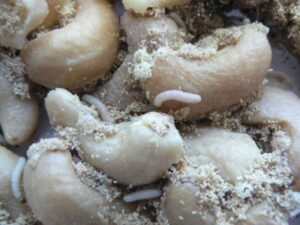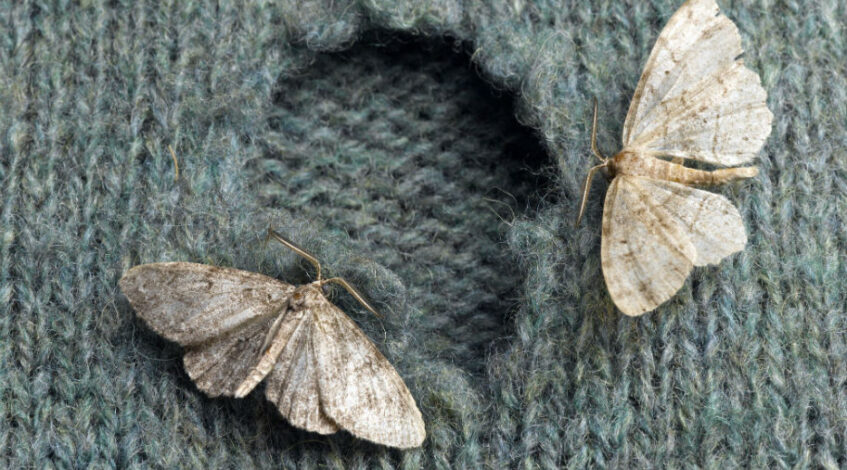Pest Info
Appearance
Moths belong to the same group as butterflies, however are generally less popular and not as flashy in appearance. Both have large compound eyes, long antennae and tube-like mouthparts that are rolled up when not in use. Their 4 membranous wings are covered in a double layer of overlapping scales, which can be brightly coloured and elaborately patterned.
“Pantry moth” is a term used to describe several different species of moths that invade our kitchen cupboards. This includes the Indian meal moth, Mediterranean flour moth and other grain moths and seed moths. These different species are all quite similar in their general lifestyle and appearance, hence the collective name “pantry moths”.
Pantry moths are generally small, with a wingspan of around 15 mm and a body length of 10-20 mm. They are mostly brown or grey in colour. Like many moths, they are nocturnal and are often attracted to lights at night.
Breeding
 Pantry moths have a complete lifecycle with an egg, larva, pupa and adult stage.
Pantry moths have a complete lifecycle with an egg, larva, pupa and adult stage.
Adult moths use pheromones to locate each other in the dark. After mating, females lay their eggs individually or in small masses on open food products and storage containers. They can produce 150-400 eggs, which will hatch into tiny larvae.
The caterpillars are generally pale yellow or cream in colour, with a dark brown head. They will shed their skins 5 to 7 times, growing rapidly between each moult. They form a tiny silken cocoon, from which they will emerge as an adult.
The entire lifecycle from egg to adult takes around 4-8 weeks, depending on the temperature.
Habitat
The majority of moths that are pests of stored products are not native to Australia and have been accidentally brought here through ships and trading. Moths frequently infest foods whilst they are in storage and during transit. Their small size means they often remain undetected. In fact, many household infestations occur when we purchase food that is already infested and unknowingly bring these pests into our homes.
In the wild, these moths would be scavengers of plant products, living on seeds, fruit and leaves. But they can readily adapt to indoor environments. And while they flourish in warm habitats, they are very hardy and larvae can survive temperatures as low as 10 degrees Celcius.
Diet
The adult moths are not to blame for destroying your food. They have tiny mouthparts and generally do not feed. It’s their hungry larvae that do the damage, and they will munch through almost any kind of stored product including flour, cereals, seeds, powdered milk, dried fruits and nuts, pasta, rice, biscuits, chocolate and dry pet foods and bird seed.
As the larvae feed, they will cover the surface with silken webs which they use as shelter. Frass and food particles cling to the silken strands and webs are often the first signs we see of an infestation.
Pest Dangers
Pantry moth infestations are not only annoying but can cost us significantly by rendering our foods inedible. And they have expensive taste – devouring costly foods items such as dried fruits, nuts and chocolate.
- The chewing action of larvae directly damages food products.
- Larvae also indirectly reduce the quality of food by contaminating it with shed skins, droppings and dead individuals.
- Feeding and growing larvae produce a lot of metabolic heat, which increases moisture and temperature. Bacteria and moulds flourish in these humid environments, speeding up the process of food spoilage.
Pest Prevention
Once pantry moths have become established in your home, they are very difficult to eliminate. However, an infestation can often be avoided in the first place by being vigilant, adopting thorough cleaning practices and restricting the moth’s access to available food.
- Be careful when purchasing food products. Avoid any broken or damaged packaging & check for signs of silk webbing, larvae or their frass.
- Buying organic cereals, nuts and spices from health food shops and markets can be risky. Try and opt for pre-packaged items, rather than filling your own bags from bulk quantities.
- Try buying smaller amounts of foods you use infrequently, so you reduce the length of time items are stored within your pantry.
- Store all of your food in air-tight containers, preferably glass jars with screw-top lids. Ensure lids are screwed on tightly after use.
- Wipe up any spills on your benches and in your cupboards. Female moths can deposit hundreds of eggs on tiny crumbs and flakes of food.
- Infestations often originate from dry dog & cat food or birdseed stored in open containers. Make sure all food items (whether they are for humans or animals) are stored in air-tight containers.
- Place flours, grains and rice in containers and store in the freezer for a week. This will kill any eggs, larvae or adults, without affecting the quality of your food.
- Food can also be heated in boiling water or in the oven to kill moths and their larvae. This is a good method for foods such as nuts and dried fruits.
- If you do find infested food in your cupboard, dispose of it immediately. Treat remaining food items using the methods above, vacuum thoroughly & then wipe down shelves with hot water.
- Ensure all food is stored in air-tight containers before returning to the cupboard.
- Be vigilant! Be on the constant lookout for adult moths resting on your walls and signs of silk and frass in your food. Sticky traps available from your supermarket won’t control an infestation, but are a good way to monitor your home for months.
Did you know?
- Pantry moths are pretty talented when it comes to getting into our food. Adults can squeeze through holes as small as 3mm in diameter. And larvae simply chew holes through plastic bags, cardboard boxes and wrappers to get to your goodies.
- As much as we can loathe sharing our home with them, natural enemies such as geckoes and spiders are one of the most efficient ways to reduce moths in your home. Just think of it as the lesser of two weevils…oops, I mean evils!
Pest Response
Once pantry moths have been established in your home, it is almost impossible to remove them without professional help. Sticky traps and pheromone traps will reduce adult moths, but will not target the larvae or eggs hidden within your food. And over-the-counter dust and surface sprays contain toxic chemicals which can be risky when used around food products.
Our recommended pest control can help! They provide pest control treatments that are environmentally friendly, child and animal safe and can be specifically tailored to suit your needs.
Our pest control specialists will thoroughly inspect your home to determine the extent of your moth problem and will recommend an appropriate action plan. Specifically targeted chemicals will rapidly knock down moths, without any harm to your food or your family’s health.

